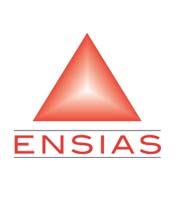- Accueil
-
L'Ecole
-
FORMATIONS
-
FORMATION INGENIEUR
-
Nouvelles filières offertes
- Ingénierie Intélligence Artificielle (2IA)
- Smart Supply Chain & Logistics (2SCL)
- Business Intelligence & Analytics (BI&A)
- Génie de la Data (GD)
- Génie Logiciel (GL)
- Ingénierie Digitale pour la Finance (IDF)
- Smart System Engineering (SSE)
- Data and Software Sciences (D2S)
- Cybersécurité, Cloud et Informatique Mobile (CSCC)
- REGLEMENT DES ETUDES DE L’ENSIAS CYCLE INGENIEUR
-
Nouvelles filières offertes
-
FORMATION INGENIEUR
- FORMATION CONTINUE
-
Recherche
- INTERNATIONAL
- ENTREPRISES
- VIE ESTUDIANTINE
- BIBLIOTHEQUE
LES DERNIÈRES INFORMATIONS
Analogy-based software development effort estimation: A systematic mapping and review
| Titre | Analogy-based software development effort estimation: A systematic mapping and review |
| Publication Type | Journal Article |
| Year of Publication | 2015 |
| Authors | Idri, A, Amazal, FAzzahra, Abran, A |
| Journal | INFORMATION AND SOFTWARE TECHNOLOGY |
| Volume | 58 |
| Pagination | 206-230 |
| Date Published | FEB |
| ISSN | 0950-5849 |
| Abstract | Context: Analogy-based Software development Effort Estimation (ASEE) techniques have gained considerable attention from the software engineering community. However, existing systematic map and review studies on software development effort prediction have not investigated in depth several issues of ASEE techniques, to the exception of comparisons with other types of estimation techniques. Objective: The objective of this research is twofold: (1) to classify ASEE studies which primary goal is to propose new or modified ASEE techniques according to five criteria: research approach, contribution type, techniques used in combination with ASEE methods, and ASEE steps, as well as identifying publication channels and trends and (2) to analyze these studies from five perspectives: estimation accuracy, accuracy comparison, estimation context, impact of the techniques used in combination with ASEE methods, and ASEE tools. Method: We performed a systematic mapping of studies for which the primary goal is to develop or to improve ASEE techniques published in the period 1990-2012, and reviewed them based on an automated search of four electronic databases. Results: In total, we identified 65 studies published between 1990 and 2012, and classified them based on our predefined classification criteria. The mapping study revealed that most researchers focus on addressing problems related to the first step of an ASEE process, that is, feature and case subset selection. The results of our detailed analysis show that ASEE methods outperform the eight techniques with which they were compared, and tend to yield acceptable results especially when combining ASEE techniques with Fuzzy Logic (FL) or Genetic Algorithms (GA). Conclusion: Based on the findings of this study, the use of other techniques such FL and GA in combination with an ASEE method is promising to generate more accurate estimates. However, the use of ASEE techniques by practitioners is still limited: developing more ASEE tools may facilitate the application of these techniques and then lead to increasing the use of ASEE techniques in industry. (C) 2014 Elsevier B.V. All rights reserved. |
| DOI | 10.1016/j.infsof.2014.07.013 |
Revues:
LIENS UTILES
Localisation
Contactez-nous
ENSIAS
 Avenue Mohammed Ben Abdallah Regragui, Madinat Al Irfane, BP 713, Agdal Rabat, Maroc
Avenue Mohammed Ben Abdallah Regragui, Madinat Al Irfane, BP 713, Agdal Rabat, Maroc
![]() Télécopie : (+212) 5 37 68 60 78
Télécopie : (+212) 5 37 68 60 78
![]() Secrétariat de direction : 06 61 48 10 97
Secrétariat de direction : 06 61 48 10 97
Secrétariat général : 06 61 34 09 27
Service des affaires financières : 06 61 44 76 79
Service des affaires estudiantines : 06 62 77 10 17 / n.mhirich@um5s.net.ma
CEDOC ST2I : 06 66 39 75 16
Résidences : 06 61 82 89 77
- Compteur de visiteurs:634,830
Education - This is a contributing Drupal Theme
Design by WeebPal.
Design by WeebPal.



































